Scotch Macaskill's Wildlife Blog
IMPORTANT: Please note that from April 2009 this Blog's Web address changed as a result of a switch in the blogging platform we use. It's still an integral part of the Wildlife Pictures Online website and, we hope, will continue providing entertaining and enjoyable content in the form of wildlife images, news, views and information.
For the most recent posts, links, and other resources, please visit the new Wldlife Photography Blog.
|
Today's Picture: Captive Chimpanzee, Close-up
May 1, 2008
|
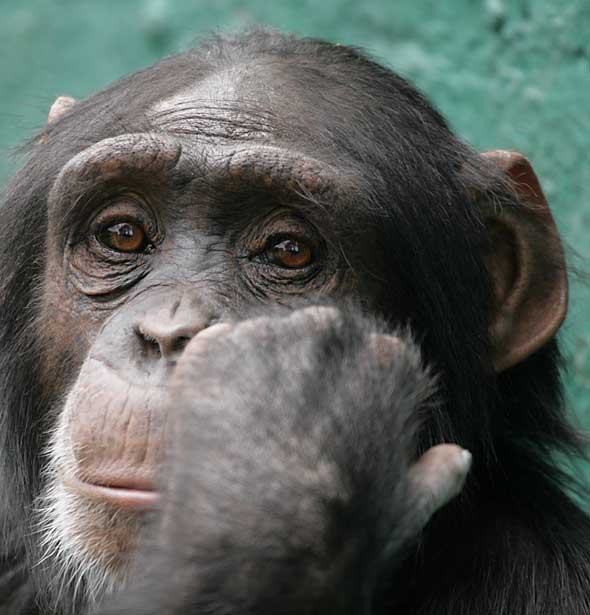
Photo Details: Chimpanzee (Pan troglodytes) close up, Natal Zoological Gardens, KZN, South Africa.
Camera: Canon EOS 400D; Lens: Canon 100-400 IS Zoom; Focal Length: 400mm; Shutter speed: 1/200; Aperture: f5.6; ISO: 400.
Additional Info: Chimpanzees, along with gorillas, humans, and orangutans, are members of the Hominidae family but it is chimpanzees that are the closest living evolutionary relatives to humans. We shared a common ancestor with chimpanzees five to eight million years ago. Ground-breaking research by Mary-Claire King in 1973 found 99% identical DNA between human beings and chimpanzees, although other researchers put the figure closer to 94%.
Renowned primatologist Dr Jane Goodall, who has dedicated her adult life to studying chimpanzees, says the "structure of the chimpanzee brain is startlingly similar to that of the human".
To quote from the Jane Goodall Institute website:
Once we admit that we are not the only beings with personality, reasoned thought, and above all, the ability to feel and express emotions such as joy, despair and empathy, then we develop a new respect for chimpanzees. The line between human and other non-human beings, once thought so sharp, becomes blurred. This forces us to a new respect also for the other amazing animal beings with whom we share the planet.
|
Today's Picture: Captive Chimpanzee No.3
May 2, 2008
|
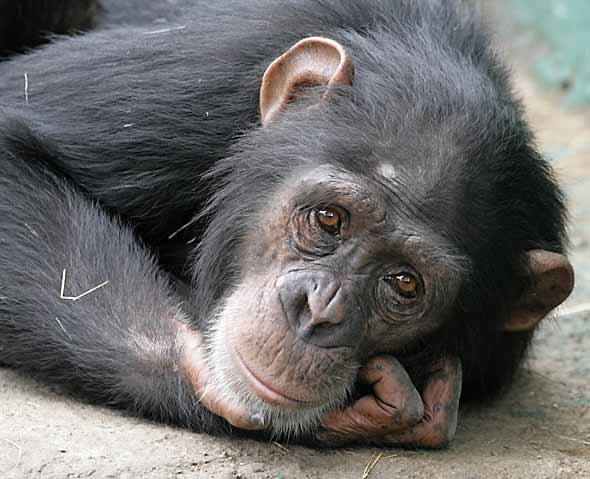
Photo Details: Chimpanzee (Pan troglodytes) lying on concrete step with its head on its hand, Natal Zoological Gardens, KZN, South Africa.
Camera: Canon EOS 400D; Lens: Canon 100-400 IS Zoom; Focal Length: 310mm; Shutter speed: 1/80; Aperture: f5.6; ISO: 400.
Additional Info: This is the third in a series of pictures showing captive chimpanzees. It's the chimps' eyes that get to me, leaving me to ponder what's going through their minds.
A reader of the blog, commenting on the first picture, asks: "How are these chimps treated anyway? I know of several chimps that are in captivity, and they are so happy, lively and content. Their owners are really looking after them. Why is this one so sad?"
From my superficial observation, I can't say how they're treated but my guess is pretty well compared to many captive chimps, specially those held in small cages. The enclosure is fairly large with a sloping, grassed area leading to concrete steps and a water-filled moat. There is a system of poles and ropes to climb, plus a weather-proof hut they can access when they want.
I'm sure they're well-fed and receive all necessary medical treatment. The owners of the zoo are animal trainers, so it makes economic sense to look after the inmates.
I obviously can't comment on whether the chimps are sad or happy. They certainly make me feel sad. But my guess is that they're simply incredibly bored, with nothing to challenge their survival instincts.
Richard Despard Estes in his book The Behavior Guide to African Mammals, describes the chimpanzee as "volatile, indvidualistic, independent". He adds that "its size, superhuman strength (an adult male has the strength of three men) and climbing skill afford it independence, there being little to fear in the forest from creatures other than men and leopards". This allows chimpanzees to "wander freely through Africa's forests and woodlands".
These chimpanzees have lost the independence that allows their relatives in the wild to wander freely where they want.
|
Today's Picture: Captive Chimpanzee No.4
May 4, 2008
|
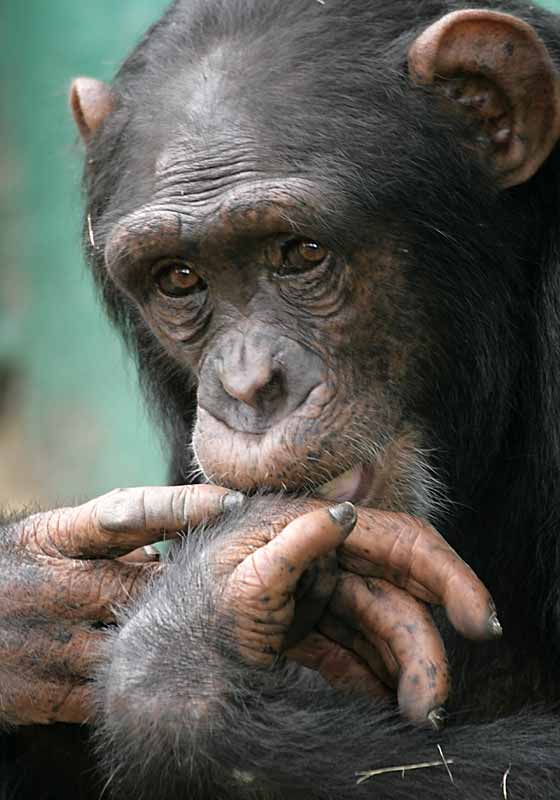
Photo Details: Chimpanzee (Pan troglodytes) with hands to its mouth, Natal Zoological Gardens, KZN, South Africa.
Camera: Canon EOS 400D; Lens: Canon 100-400 IS Zoom; Focal Length: 400mm; Shutter speed: 1/60; Aperture: f5.6; ISO: 400.
Additional Info: The discovery that chimpanzees use "tools" for certain purposes surprised the world. But it's now accepted that they posseses the skill and intelligence to prepare and use grass stems and sticks to fish for insects, hammer with and throw stones, strip leaves from a branch, peel fruit, and the like.
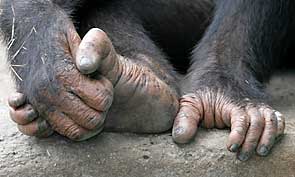
They have hands that can grip firmly, allowing them to pick up objects. However, the long hands and fingers combined with a short thumb (below left) prevent prevent them from opposing the thumb and fingertips. They can nevertheless pick up small objects between the thumb and side of the index finger. In addition, the feet are adapted for grasping, with a long, stout, opposable big toe (see right, and below right, where the foot is being use to grasp a hand).
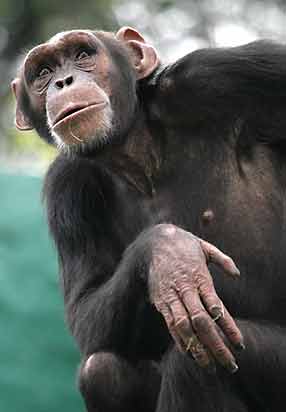
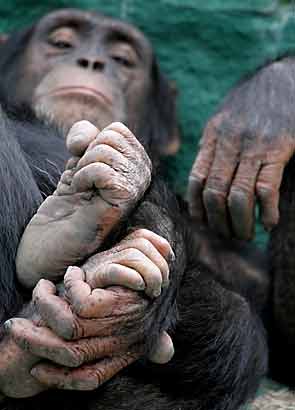
|
Today's Picture: African Hawk Eagle
May 14, 2008
|
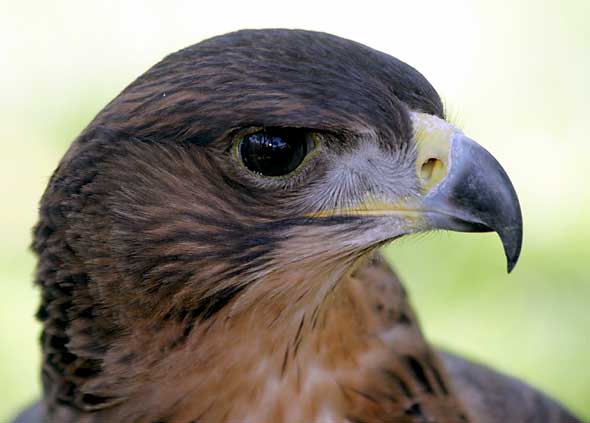
Photo Details: Close-up of immature African Hawk Eagle (Hieraaetus fasciatus), Palace of the Lost City, South Africa.
Camera: Canon EOS 400D (Digital Rebel XTi); Lens: Canon EOS 70-300 IS Zoom; Focal Length:190mm; Shutter speed: 1/200; Aperture: f5.6; ISO: 400.
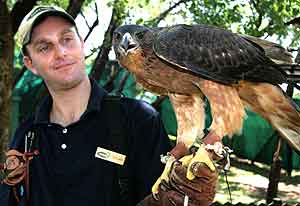
Additional Info: This impressive looking raptor, still a juvenile, was photographed during a falconry training session with its falconer (handler) - see picture right, which gives an idea of the size of the bird. Wikipedia defines falconry or hawking as "an art or sport which involves the use of trained raptors (birds of prey) to hunt or pursue game for humans".
The rufous coloring of the underparts found in immature African hawk eagles becomes white on the central belly and chest of the adult bird, with clearly defined dark spots.
|
Today's Picture: Lioness Pair
May 17, 2008
|
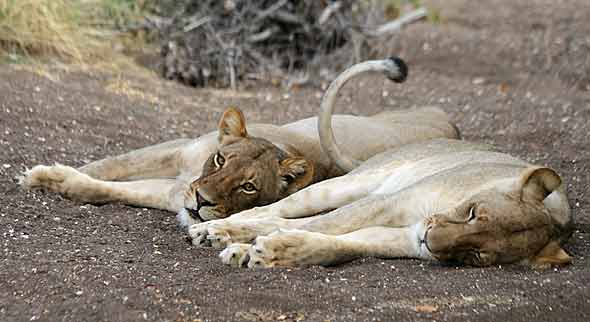
Photo Details: Lioness pair (Panthera leo) at rest in dry riverbed, Mashatu Game Reserve, Tuli Block, Botswana.
Camera: Canon EOS 400D (Digital Rebel XTi); Lens: Canon EOS 70-300 IS Zoom; Focal Length:210mm; Shutter speed: 1/400; Aperture: f5; ISO: 400.
Additional Info: Sleeping lions do not make interesting photographic subjects. And lions sleep a lot - up to 20 hours a day. But it's often fitful dozing rather than a heavy slumber, so it's a good idea to be ready for any sudden movement.
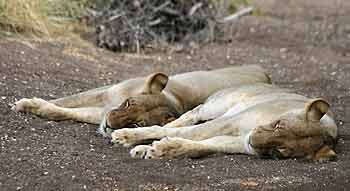
In the picture above, a glance from the one lioness, and a flick of the tail from the other - to let us know they were aware of us - turned an othewise boring picture into an interesting composition. The eye is drawn to the dark head amongst all the legs and feet, then follows the curve of the tail out of the picture and back in again. A moment after the picture was taken (right) it was back to sleep (apparently!).
|
Today's Picture: Kori Bustard
May 19, 2008
|
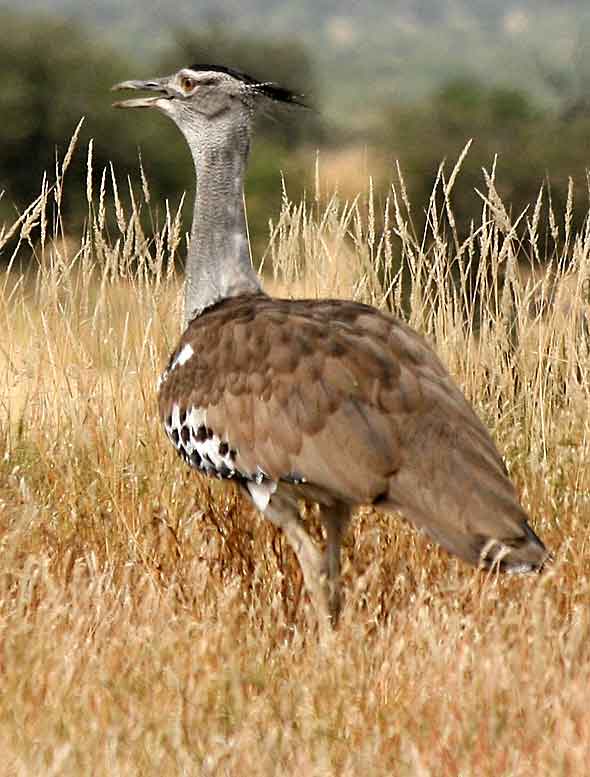
Photo Details: Kori bustard (Ardeotis kori) walking through grassland, Mashatu Game Reserve, Tuli Block, Botswana.
Camera: Canon EOS 400D (Digital Rebel XTi); Lens: Canon EOS 70-300 IS Zoom; Focal Length:300mm; Shutter speed: 1/1250;
Aperture: f8; ISO: 400.
Additional Info: The Kori bustard (also called "gompou" in South Africa) is one of the world's largest flying birds, weighing up to 17kg
(37lb) and standing up to 1.5m (nearly 5ft) tall. Despite a wingspan of around 2.5m (8ft), the Kori bustard is a reluctant flyer, needing a good
run-up to become airborne. This preference for land-based activity means kori bustards can quite often be seen striding around in their favored
habitat - arid, open regions, grassy plains and savannah bushveld. They are omnivorous and their diet includes insects like grasshoppers and beetles, plus scorpions, snails, small reptiles and also seeds, berries, and bulbs.
|
Today's Picture: Red Hartebeest Herd
May 21, 2008
|
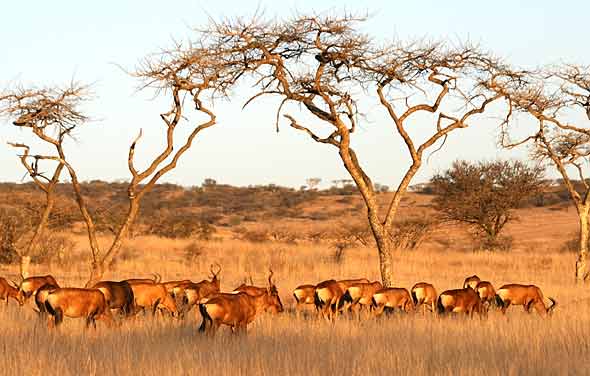 Photo Details: A herd of red hartebeest (Alcelaphus buselaphus), framed by acacia thorn trees typical of the area, grazes on winter grass in the late afternoon, Spioenkop Game Reserve, KwaZulu-Natal, South Africa.
Photo Details: A herd of red hartebeest (Alcelaphus buselaphus), framed by acacia thorn trees typical of the area, grazes on winter grass in the late afternoon, Spioenkop Game Reserve, KwaZulu-Natal, South Africa.
Camera: Canon EOS 400D; Lens: Canon 70-300 IS Zoom; Focal Length: 130mm; Shutter speed: 1/250; Aperture: f8; ISO: 200.
Additional Info: Red hartebeest are principally grazers found in open grassland and were originally widely distributed in southern Africa before hunting and human habitation took their toll. They have been re-introduced in parts of KwaZulu-Natal, including Spioenkop Game Reserve. Steeped in Anglo Boer War history, Spioenkop is host to a diverse range of
wildlife, including white rhinoceros, giraffe and a variety of plains and bushveld antelope.
|
Today's Picture: African Rock Fig
May 27, 2008
|
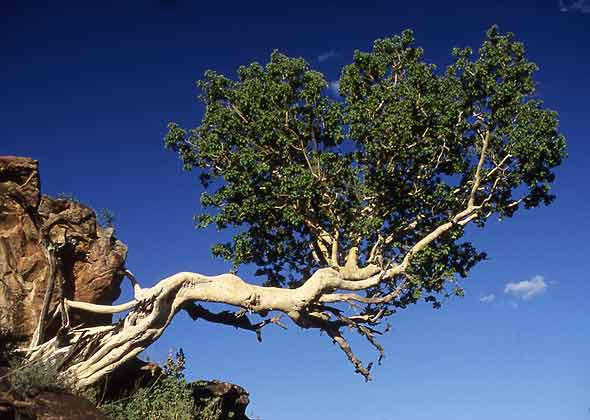
Photo Details: African rock fig (Ficus glumosa) - a portion of its trunk horizontal to the ground - growing from a rocky outcrop, Mashatu Game Reserve, Tuli Block, Botswana.
Camera: Canon EOS Elan film camera, Sigma 24mm lens with polarising filter, using Fuji transparency film.
Please Note: Pictures displayed on this blog are copyright protected. View them online, enjoy them, but kindly do not use them for anything else.
Should you wish to purchase an image or require clarification on use, please contact me.
|
| |
| Back to top of page
|
|
Previous Entries
By Month
By Category
My Original Blog
2005 Entries
2004 Entries
2003 Entries
Who Am I?
Brief Bio
|












 Photo Details: A herd of red hartebeest (Alcelaphus buselaphus), framed by acacia thorn trees typical of the area, grazes on winter grass in the late afternoon, Spioenkop Game Reserve, KwaZulu-Natal, South Africa.
Photo Details: A herd of red hartebeest (Alcelaphus buselaphus), framed by acacia thorn trees typical of the area, grazes on winter grass in the late afternoon, Spioenkop Game Reserve, KwaZulu-Natal, South Africa.
